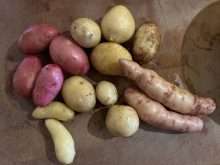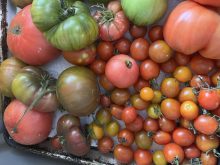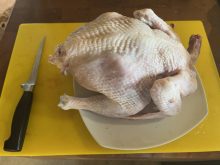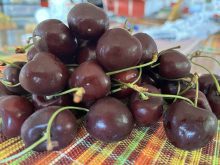I received a wok and cookbook recently. The 14-inch wok has a long wooden handle and a looped helper handle on the opposing side. The book, The Wok: Recipes and Techniques, is by J. Kenji López-Alt, a cook, an MIT-trained scientist and architect, and author of The Food Lab: Better Home Cooking Through Science. His intelligent blend of science and food lore earned him awards and admirers, including me. So I expect information and great recipes in my new cookbook. And, yes, it’s all there.
Before cooking anything with it, I season my new wok. Carbon steel rusts, as anyone who owns their grandfather’s old bread knife already knows. Woks made of carbon steel are coated with machine oil to prevent rust or tarnishing in the store. I scrub it with steel wool and hot soapy water, dry it, then put it on the stove over a high flame, tilting and rotating the wok until the entire thing takes on a blue-ish haze. This readies the metal for seasoning so it will be non-stick. I use my gas range, but a blowtorch or outdoor grill works too. I wash and dry my wok again and rub it inside and out with sunflower oil (I’ll gently wash, heat and oil the wok after each use until it’s completely seasoned). I hang it up on my pot rack. I love the latent energy captured in that blue tinge.
My new book tells me about the science behind the tossing action made easy by a wok’s sloping sides and so integral to wok cooking. At cooking school, I learned to toss raw rice in a dry sauté pan before I was allowed to add vegetables. That long slow parabola of food arcing from the pan into the air and falling gracefully back into the pan makes it easier to toss fragile foods.
Read Also

Gentle treatments for pain in the neck
Heading toward year-end, people unknowingly tense up against the cold and busyness, causing neck pain that can often be treated with appropriate support and gentle mobility, athletic therapist Kathlyn Hossack says.
But there’s more to it than speed and eliminating the use of a utensil.
A column of hot air and steam rises up from a wok, which means during the toss so integral to the process, flying food in the air is coated with steam. This translates into latent energy that heats those food particles before they tumble back into the wok, which, while briefly empty, has regained heat energy.
Aha. So my impression of that blue-tinged wok’s latent energy is bang on. Ain’t it grand? Science on the move. First we eat, then we talk chemistry.
Learning the toss
Try this with a small sauté pan before your wok. Practising will inevitably land rice on the floor, but soon you will find a smooth circular motion.
Put one cup of raw rice into the dry pan.
Holding the wok by its long handle, tilt the pan down and away so the rice sits at the far side.
Push the pan away from you smoothly. Tilt the pan upward and pull it back toward you, jerking it upward halfway through. The rice should fall up, then cascade back downward.
Catch the food as you bring the pan back toward yourself. Repeat.

Tumble-Tossed Grean Beans, Velvet Chicken and Almonds in Orange-Lemon Sauce
This recipe is adapted from The Wok: Recipes and Techniques by J. Kenji López-Alt. He prefers the terms “tumble-fry” or “toss-fry” to “stir-fry,” which suggests simply pushing food around with a wooden spatula. As always with a stir-fry, chop and measure everything in advance of cooking. Serves 4.
Meat and marinade:
- 1 pound chicken breast, diced into 1/2-inch pieces
- 1 teaspoon kosher salt
- 4 teaspoons light soy sauce 2 teaspoons cornstarch
- 1/2 teaspoon baking soda
- 1 egg white
Beans and sauce:
- 1 pound green beans, cut in 2-inch lengths
- 1 tablespoon light soy sauce 2 tablespoons dry sherry
- 1/4 cup chicken stock or water 1/4 cup orange juice
- 1 tablespoon lemon juice
- 1 teaspoon roasted sesame oil 2 teaspoons sugar
- 2 teaspoons cornstarch
- 1 tablespoon water
Tumble-toss:
- 2 tablespoons vegetable oil 1 lemon, zest only
- 1 orange, zest only
- 4 garlic cloves, minced
- 1 tablespoon minced fresh ginger 3 green onions, minced
- 1/2 cup whole almonds, toasted Kosher salt to taste
Wash the meat in cold water, drain and press out remaining water. Mix the meat and marinade ingredients in a bowl. Let sit for 30 minutes at room temperature.
Bring four cups of salted water to a boil in a medium pot. Use spring- loaded tongs to add the meat one piece at a time and simmer for one minute when it’s all in. Use a small strainer, spider or perforated spoon to remove the meat to a plate lined with paper towel. Spread into a single layer to dry for several minutes.
Bring water back to the boil. Add beans and blanch until tender. Drain and set aside.
Mix together all ingredients for sauce except the cornstarch and water. Put cornstarch and water in a ramekin. Mix well.
Heat wok over high heat until just smoking. Add oil and swirl to coat. Add zests, garlic and ginger. Stir and cook for 10 seconds. Add green onions, beans and chicken. Stir-fry until the chicken is cooked through, about one minute.
Stir sauce ingredients and add to wok along the outer edges. Stir cornstarch slurry and add part of it. Tumble-toss until sauce thickens, adding more slurry as needed if sauce is not thick enough, or water if it’s too thick. Add almonds and salt to taste. Toss. Transfer to a platter and serve with rice.















